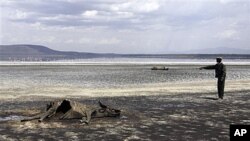Kenya ranks near the bottom of the world in food security. While the government works to stave off a coming drought, experts say Kenya must retool its local food markets to prevent future shortfalls.
As World Food Day approaches, Kenya stands at a crossroads in its fight to end hunger. The east African nation boasts one of the largest economies on the continent, with a highly developed agricultural sector ranked as one of the world's leading exporters of tea, coffee and flowers.
Kenya rated 'high risk'
But despite its potential, Kenya is one of the most food-insecure nations on the planet. United Kingdom-based risk consultants Maplecroft ranked Kenya 21st among 163 countries in their 2010 Food Security Risk Assessment. The consultants, who frequently collaborate with the United Nations, rated Kenya as 'high risk," placing it ahead of such countries as Pakistan, at 30; and Iraq, at 59.
Environmental factors play a large role in Kenya's food insecurity. Much of Kenya's eastern and northern regions are fairly dry, and inhabitants rely on seasonal rains to survive. In 2008 and 2009, unusually light rains proved disastrous, sending food prices up and triggering massive shortages.
But according to the managing director of the Rockefeller Foundation's Africa Program, Dr. James Nyoro, the problem has as much to do with structural issues in Kenya's economy. "This is ironical because when you look at the infrastructure, Kenya is doing better than all the others within the region. But you are talking about a huge population; you are talking about very well advanced horticultural system, very well advanced coffee and tea systems. So Kenya has utilized most of its good potential to produce high-value exports. And as a result of that it has traded off producing food."
Growing food gap
The gap between supply and demand has been growing in Kenya since the 1990s, but Kenya's producers have not moved to meet the increased need.
According to Nyoro, Kenya lacks a modern commodity exchange that can take advantage of its production potential. Farmers must instead rely on what he calls "extremely unpredictable prices" set by the government to sell staple crops such as corn.
"Kenya has not been able to put in an efficient food marketing system that ensures that if you invest as a small scale-farmer or medium-scale farmer in maize production that at the end of the season you will be able to get a good market and get your returns," said Nyoro. "The marketing system has not been very well established and it has been kind of monopolized by the National Cereals and Produce Board which is a government body."
Coming drought predicted
Early 2010 turned out to be a season of surplus for Kenyan farmers. Higher than average rainfall helped speed the recovery from consecutive seasons of drought.
But early reports of a "La Nina" weather system have analysts predicting another season of drought in the coming months. Nyoro warned that Kenya will have to build up its national grain reserves through imports to prevent famine.
The Kenyan government seems to agree. The Ministry of Agriculture announced on Tuesday it will double the reserves from 360 million kilograms to around 720 million kilograms in anticipation of a shortfall.
Proactive measures
In Northeastern Province, one of the country's driest regions, officials also are working to keep harvests from failing. According to the Provincial Director of Agriculture, Shikuku Mushieni, farmers are being given tools to make the most of the marginal rains.
"The government, through the Ministry of Agriculture, has supplied a total of 30 tons of assorted drought-tolerant crops and we are distributing it to the farmers throughout the province," said Mushieni. "Secondly, we have irrigation schemes along the two major rivers, River Tana and River Dawa, where farmers are working in groups and planting various crops. Therefore, we look forward to a season whereby the little rain that shall be received - the farmers will be able to use it effectively to produce food for the province."
In 2009 the Kenya Food Security Steering Group - made up of officials from Kenya, the United Nations, NGOs and the Famine Early Warning System Network - estimated 3.8 million people were in need of emergency food assistance from September until February. A recent assessment by the group found that nearly 2 million would need food assistance through December of this year.










